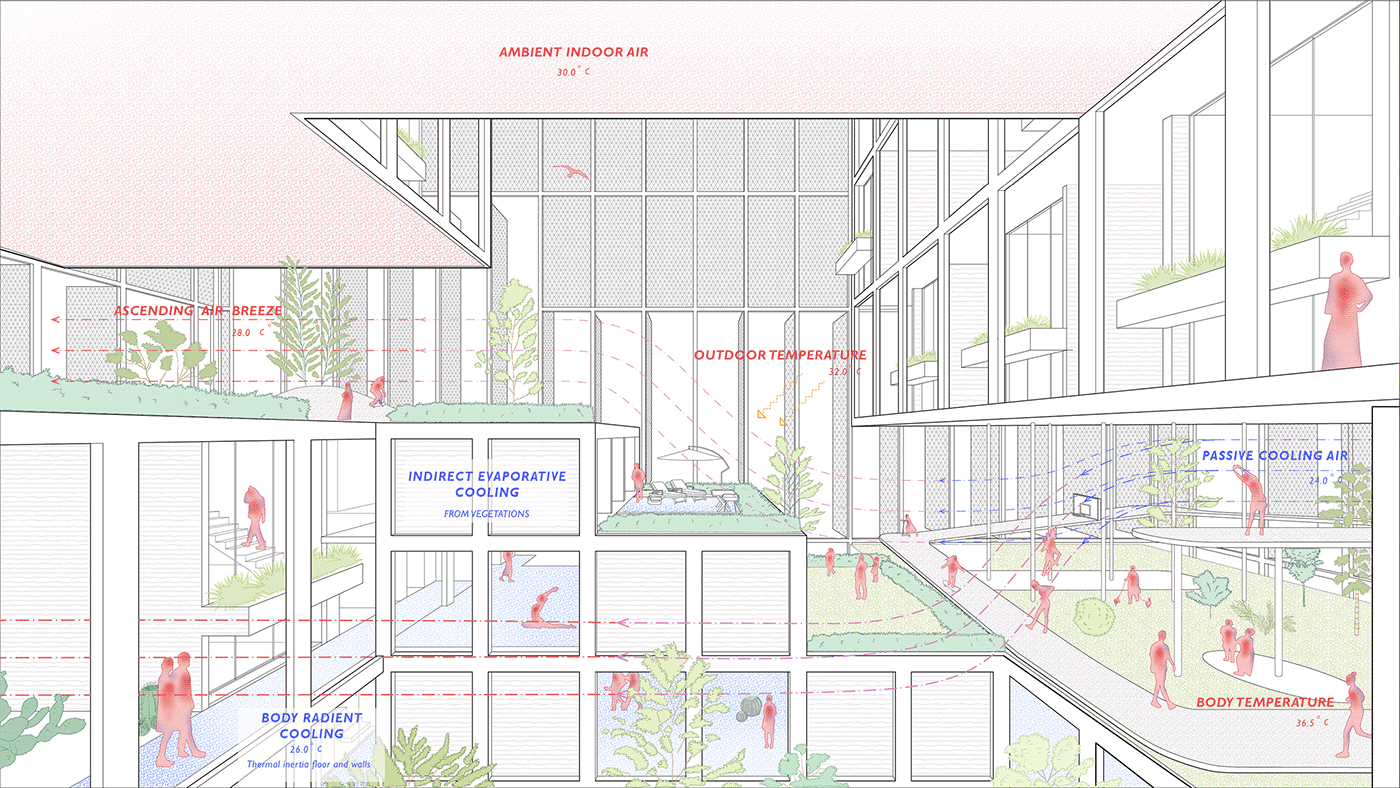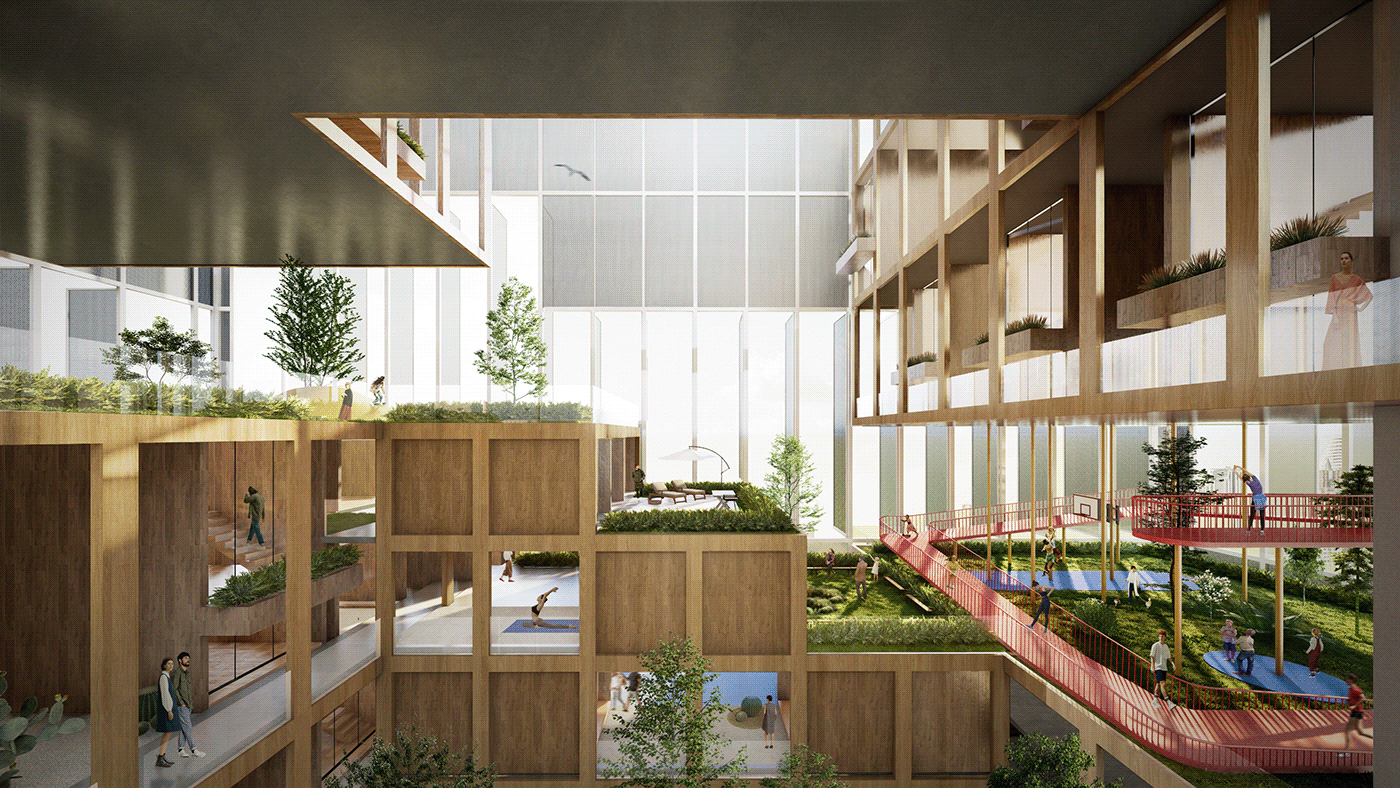PORO | CITY
2022
IAAC - Master in Advanced Ecological Buildings and Biocities
By Andrea Paola Rubio Paredes / Pongpol Punjawategul / Suwapat Rodprasert
The project is developed in ‘Sociopolis’, a proposed urban development project, planned and partially realized in Valencia, Spain during 2002 - 2010. The design intended to instigate a synergistic, biodynamic community to house those typically underserved by municipal public housing efforts in Spain.
PORO I CITY is a mass timber building, served to be a residential program in which 20% of the building is provided for Recreational & Sports Facilities. Within the building, it pursues an architecture of in-between recreational spaces, floating and connecting systems that allow better ways of creating different typologies of public space that promote more collective interactions between all users. Through the flexibility of mass timber construction, thermodynamics, and self-sufficient strategies, Poro-city provides feasibility to re-imagine cities that can re-adapt socially, economically, and sustainable ways of living.


COMFORT AND HUMAN PHYSIOLOGY AND PSYCHOLOGY
Responding to thermodynamic aspect, the diagram illustrates the human actions toward different activities, spaces, and times of the day in the Mediterranean climate for both Summer and Winter seasons whether from the clothes that they are wearing or the space that they occupied.

PRE-DESIGN CLIMATE PROTOTYPE
From the studies before jumping into the big scale building, this prototype was created to analyze the ventilation regarding the Thermodynamic studies. These 2 prototypes illustrate different climatic reactions in specific periods of time. The operable mesh and window can be opened to maximize the ventilation during hot summer. Meanwhile, during the cold winter, they can be closed to break the wind but still allow the sunlight to penetrate through for thermal gain.


CLIMATIC STRATEGIES – MASSING
The prototype’s strategy is now applied to a bigger scale as a whole massive building.

SPORT & RECREATIONAL PROGRAMS
Since the building is placed in front of the sports field. The intention is to connect the activities & give a welcome ambiance to any users around to interact with the continuity of the underground space of the building. The section expresses the activities related to the recreational program throughout the building. Enclosing the building with operable mesh, it does not only provides ventilation with porosity but also gives an ability to adapt itself to different climates according to different seasons.

The whole building is enveloped under an operable mesh that is made out of Bio-plastic (ARBOBLEND®). The porosity and pattern of the panels vary in Residential and Common areas due to the privacy level.

COMMON AREAS / HOUSING UNITS
The building provides 2 commons area respond to the recreational program. Common 1, which served as the public area, would be totally open, clean giving chilling and festive vibes. In contradiction to the upper part of Common 2, private sports area for the residents. the programs are placed between the timber truss structure so that people could enjoy the activities surrounded by the complexity of composition.
Regarding the housing program, there are 2 types of housing units inside this building. First, the single unit, located on the lower part of the building, distribute for temporary stay for young athletes while the upper part, the Mezzanine unit, provided for a group of families who enjoys a festive and active environment. Each unit will have there own private terrace and in order to tackle the ventilation issue, the unit is layout in 1 YES 1 NO to allow wind to flow across every single unit.


Relating back to thermodynamic studies, this perspective is giving more understanding of how the climates react inside the building.







The dwellers allow controlling the mechanism of the façade themselves to respond to the climate and visuals. We see how Valencia people love the outdoors so the private terrace is given as much quality as the room.






The modular system and connections between wood pillars, beams and trusses are also acting as an important factor to allow present and future generations to adapt to different conditions through the flexibility of mass timber construction, as well as providing feasibility to re-imagine cities that can re-adapt socially, economically and sustainable ways of living














PORO|CITY is a project of IAAC, the Institute for Advanced Architecture of Catalonia, developed in the Master in Advanced Ecological Buildings and Biocities (MABB01) 2021/22
by students: ANDREA PAOLA RUBIO PAREDES | SUWAPAT RODPRASERT | PONGPOL PUNJAWAYTEGUL
Faculties : PROFESSOR JAVIER GARCIA-GERMÁN | ELENA ORTE & GUILLERMO SEVILLANO (SUMA)
PROFESSOR MIQUEL RODRIGUEZ | PROFESSOR JOCHEN SCHREER | PROFESSOR OSCAR ACEVES






